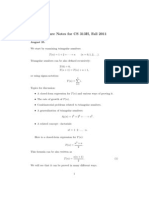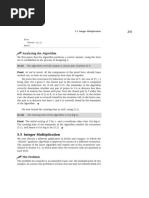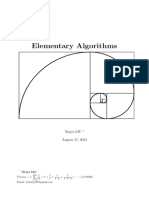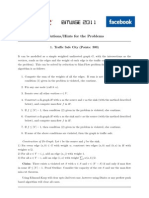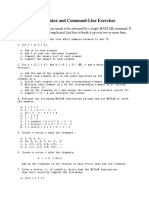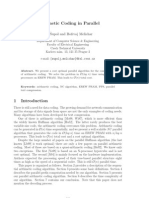Multiply Two Numbers: I I I I+1
Uploaded by
AnonymousMultiply Two Numbers: I I I I+1
Uploaded by
AnonymousA solution for the common Multiplication Problem
Multiply two Numbers
Problem: Given two numbers x and y,having n and m digits respectively, being stored in arrays
A and B of sizes n and m, compute the product of x and y using the algorithm taught in high
school.
Solution: We are going to use the algorithm taught to us in high school. First take the last digit
of one number and multiply[2] it with the other number digit by digit. If the product is less than
10, just place it to the array temp. If it is greater than 10, then place the result modulus 10 in
the array temp and carry[1] result divided by 10 to be added to the next result. When done with
this, copy the array temp to array ans. Similarly go on doing it for all the digits in that number
and keep adding the result in array temp to ans. We now state the following Lemma which briey
justies what we are doing in the algorithm.
Lemma 1. For given numbers x and y, having digits A
i
and B
i
respectively, the product of these
numbers is simply the sum of the products A
i
, y and 10
i+1
.
Proof. Basically, the array A stores the digits of the number x. So, we can write
n1
i=0
A
i
10
i+1
= x . (1)
So, the product of the two numbers can be written down in the way we have done it.
Analysis of Time and Space complexity the Algorithm
Algorithm executes one of the for loops n times, and in each iteration it executes another loop,
which in each iteration takes O(1) time. Thereafter, it spends a total of O(m n) time in the for
loop. This takes O(n m) time and O(n + m) space. So overall time complexity of the algorithm
is O(n m) and the overall space complexity is O(n + m).
In the special case, when both the numbers have n digits, the time complexity becomes O(n
2
) and
overall space complexity becomes O(n).
1 Flow Chart
Enter numbers
Multiply last digits
Carry result modulus 10
Do this for all digits of
b and add the result for
each digit of a
1
Data: Input will be two arrays A[0..n 1] and B[0...m1]. However, the algorithm will
use additional arrays temp[0..n] and ans[0....n + m] such that temp will store the
temporary product for the i iteration and L, after the last iteration, will store the
nal product.
Result: The product of the given numbers.
1 var1 n;
2 var2 0;
3 var3 0;
4 var4 0;
5 for j n + m to 0 do
6 ans[j] 0;
7 end
8 for i m1 to 0 do
9 for j 1 to n do
10 temp[n] 0;
11 end
12 for j n 1 to 0 do
13 if ((B[i] A[j]) + var2) 9 then
14 temp[var1] ((B[i] A[j]) + var2);
15 var1 var1 1;
16 else
17 temp[var1] (B[i] A[j] + var2)%10;
18 var2 (B[i] A[j] + var2)/10;
19 var1 var1 1;
20 end
21 end
22 temp[var1] var2;
23 var2 0;
24 var1 n;
25 for j (n + mi) to mi do
26 ans[j] (ans[j] + temp[j + i m] + var4);
27 var4 (ans[j] + temp[j + i m] + var4)%10;
28 end
29 ans[m1 i] var4;
30 var4 0;
31 end
32 This algorithm gives the product whose digits are stored on the array sum.
Algorithm 1: Algorithm for nding the Product of two numbers
2
6
4
2
1 2
4
1
3
6
5
0
2 0 0
2 5 8 3 0
References
[1] Rohit Kumar Jha. Carrying in numbers. 2012.
[2] Rohit Kumar Jha. How to multiply. 2012.
3
You might also like
- Fundamental Algorithms CSCI-GA.1170-001 /summer 2016 Solution To Homework 1No ratings yetFundamental Algorithms CSCI-GA.1170-001 /summer 2016 Solution To Homework 16 pages
- B-Large Integers and Strassen's MultiplicationNo ratings yetB-Large Integers and Strassen's Multiplication4 pages
- daa_02_R1_1_1c6a15d207a7c4b3a81313aa34710307No ratings yetdaa_02_R1_1_1c6a15d207a7c4b3a81313aa347103074 pages
- Algorithms - CMSC-272XX Divide and Conquer: The Karatsuba Algorithm (Multiplication of Large Integers)No ratings yetAlgorithms - CMSC-272XX Divide and Conquer: The Karatsuba Algorithm (Multiplication of Large Integers)3 pages
- Solutions/Hints For The Problems: 1. Traffic Safe City (Points: 300)No ratings yetSolutions/Hints For The Problems: 1. Traffic Safe City (Points: 300)6 pages
- Solutions To Assignment 2: Problem 1: Smallest Error in DifferentiationNo ratings yetSolutions To Assignment 2: Problem 1: Smallest Error in Differentiation3 pages
- Ald Assignment 5 & 6: Divide and ConquerNo ratings yetAld Assignment 5 & 6: Divide and Conquer16 pages
- Test 2 - Problem Solving and Design - MemoNo ratings yetTest 2 - Problem Solving and Design - Memo7 pages
- Arithmetic Coding in Parallel: Jan Supol and Bo Rivoj MelicharNo ratings yetArithmetic Coding in Parallel: Jan Supol and Bo Rivoj Melichar11 pages
- CSCI 3110 Assignment 6 Solutions: December 5, 2012No ratings yetCSCI 3110 Assignment 6 Solutions: December 5, 20125 pages
- Second Year Engineering Mathematics Laboratory Exercise 2: Eigen Systems and Pdes Hilary TermNo ratings yetSecond Year Engineering Mathematics Laboratory Exercise 2: Eigen Systems and Pdes Hilary Term9 pages
- Designe and Analysis of Algoritham Mid-Term Equivalent AssignmentNo ratings yetDesigne and Analysis of Algoritham Mid-Term Equivalent Assignment9 pages
- Generative Machine Learning For Multivariate Equity Returns: Ruslan Tepelyan Achintya GopalNo ratings yetGenerative Machine Learning For Multivariate Equity Returns: Ruslan Tepelyan Achintya Gopal13 pages
- Community Detection Using Statistically Significant Subgraph MiningNo ratings yetCommunity Detection Using Statistically Significant Subgraph Mining10 pages
















